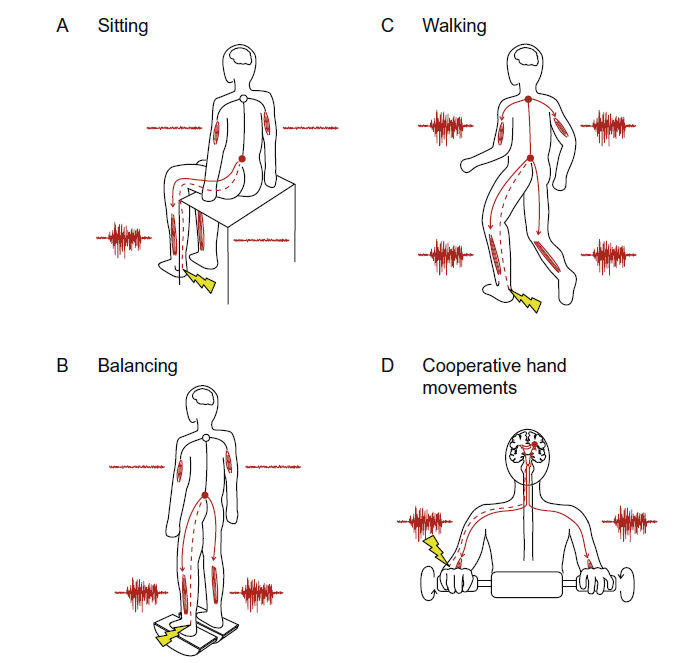Project leader: Prof. em. Dr. Volker Dietz FRCP FEAN
In recent years it has become evident that, in a number of functional movements, synergistically acting limbs become task-specifically linked by a soft-wired ‘neural coupling’ mechanism (e.g. the legs during balancing, the arms and legs during gait (1,2) and both arms during cooperative hand movements (3). Experimentally this mechanism became evident by the analysis of reflex responses as a marker for a neural coupling. It is reflected by the task-specific appearance of reflex EMG responses to non-noxious nerve stimulation, not only in muscles of the stimulated limb, but also, with same long latency, in muscles of meaningful coupled (contralateral) limb(s). These compensatory reflex responses show the same behavior in the non-stimulated limb as in the stimulated one, i.e. they exhibit an automatic gain control of reflex amplitude (4). After a stroke, nerve stimulation of the unaffected limb during such cooperative tasks is followed by EMG responses in muscles of the (contralateral) coupled affected limb, i.e. unaffected motor centres support synergistically acting movements of the paretic limb. In contrast, following stimulation of the affected limb, no contralateral responses appear due to defective processing of afferent input (5). As a consequence, it may be therapeutically possible to strengthen the influence of unaffected motor centers on the performance of affected limb movements through training of cooperative limb movements required during activities of daily living.
The mechanism of neural coupling is task-specifically involved in a number of functional movements that require cooperation between limbs for optimal performance. The defective function of the neural coupling mechanism after a stroke appears to be similar for fundamentally different motor tasks, i.e. locomotion and cooperative hand movements. The post-stroke alteration in neural control consists of preserved neural coupling from the unaffected to the affected side that leads to an almost normal activation of muscles of the paretic limb, and impaired neural coupling from the affected to the unaffected limb(s). Thus, unaffected motor control centres influence muscle activation of paretic muscles during coupled limb movements. The research achievements discussed above have implication in the neuro-rehabilitation of post-stroke subjects. The ipsilateral ascending and descending pathways to and from the unaffected hemisphere that are involved in movement control of paretic limb muscles may be strengthened by appropriate training. In addition to the focused training of affected limb(s), complex functional movements based on the mechanism of neural limb coupling should be included in rehabilitation programs. Such training approaches are associated with an activation of ‘cooperating’ paretic limb muscles, i.e. they use the influence of neural drive from unaffected motor centres for the activation of affected limb function.
Task-specific distribution of reflex responses to nerve stimulation. Schematic illustrations of the motor conditions and the corresponding distribution of EMG reflex responses to left, non-noxious tibial (A–C) or ulnar (D) nerve stimulations (indicated by arrow). (A) Sitting: an EMG response appears only in the ipsilateral tibialis anterior muscle. (B–D) Movement conditions using task-specific neural coupling of limbs. Reflex response to unilateral nerve stimulation appears not only in the stimulated leg/arm but also in limb muscles synergistically acting in the task. Neural coupling occurs between bilateral leg muscles during balancing (B), between legs and arm during walking (C) and between the arms during cooperative hand movements (D). From Dietz and Schrafl-Altermatt, Clin Neurophysiol (2016)
References
Dietz V. Do human bipeds use quadrupedal coordination? Trends Neurosci, 2002;25:462–7
Dietz V, Sinkjaer T. Spastic movement disorder: impaired reflex function and altered muscle mechanics. Lancet Neurol, 2007;6:725–33.
Dietz V, Macauda G, Schrafl-Altermatt M, Wirz M, Kloter E, Michels L. Neural coupling of cooperative hand movements: a reflex and FMRI study. Cereb Cortex, 2015;25:948–58
Thomas FA, Dietz V, Schrafl-Altermatt M (2018) Automatic gain control of neural coupling.during cooperative hand movements. Scientific Reports 8:5959/ DOI:10.1038/s41598-018-24498-6.
Dietz V, Fouad K, Bastiaanse CM. Neuronal coordination of arm and leg movements during human locomotion. Eur J Neurosci, 2001;14:1906–14
For further information please contact: Prof. em. Dr. Volker Dietz FRCP FEAN
